How to Homebrew Kombucha – Save Money and Enjoy a Healthy Drink
This post may contain affiliate links. Read my full disclosure here.

My First Homebrew Kombucha
Making homebrew kombucha is easy, once you have a kombucha culture, also known as a scoby (Symbiotic Colony of Bacteria and Yeast). My first scoby came from another homeschool mom in my natural foods co-op. Before I started brewing, I re-read the info I had on kombucha from Wild Fermentation and Nourishing Traditions. I paid my friend a quick visit, and brought home two new scobys safely packaged in a covered pyrex container. And then – my scoby sat in the fridge. (Which, BTW, is not the best thing for a scoby. Store them at room temperature with enough liquid to cover. A large mason jar works quite well.)
I was excited about the concept, but the original brew I smelled reminded me of a combination of old socks and vinegar. This made me a little nervous. I had a heck of a time tracking down an appropriate container to brew in – very few things come packaged in glass anymore, and I really didn’t need a gallon of olives. Finally, I found some nice gallon containers at Walmart. They had a lid that I didn’t need, but the ridge around the top was handy for holding the rubber band in place that kept the cloth covering the brew in place.
No more excuses – old sock smell or not, it was time to take the plunge. I used the recipe from Wild Fermentation, shown below. I make three quarts at once and ferment them in a gallon container. If you don’t have a neighbor with a scoby, I recommend fresh cultures from Kombucha Kamp.
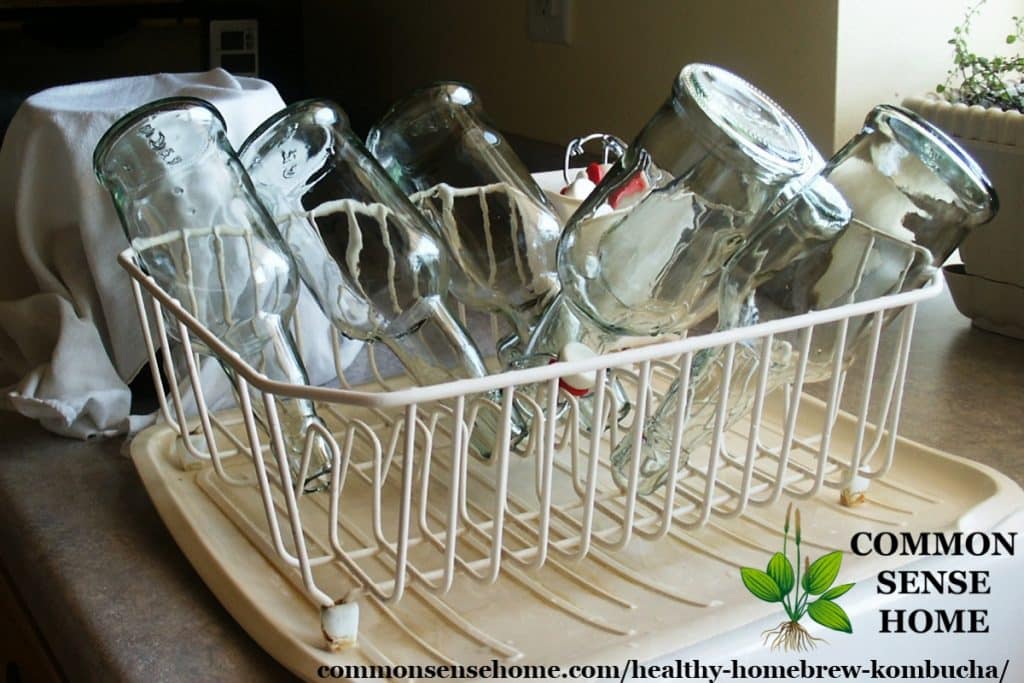
Homebrew Kombucha instructions
Kombucha Brewing Timeframe
About 7-10 days
Ingredients (for 1 quart/1liter)
1 quart/1liter water
1/4 cup/60 milliliters sugar
1 tablespoon/15 milliliters loose black tea or 2 teabags
1/2 cup/125 milliliters mature acidic kombucha
Kombucha mother (SCOBY)
Directions
- Mix water and sugar and bring to a boil in a small cooking pot.
- Turn off the heat; add tea, cover, and steep about 15 minutes.
- Strain the tea into a glass container. It’s best to use something wide; kombucha needs adequate surface area and works best if the diameter of the container is greater than the depth of the liquid. Allow the tea to cool to body temperature.
- Add the mature acidic kombucha. When you obtain a culture, store it in this liquid. Save a portion of the subsequent batches for this purpose.
- Place the kombucha mother in the liquid, with the firm opaque side up.
- Cover with a cloth and store in a warm spot, ideally 75- to 85F (21 to 29 C).
- After a few days to 1 week, depending on the temperature, you will notice a skin forming on the surface of the kombucha. Taste the liquid. It will probably still be sweet. The longer it sits, the more acidic it will become.
- Once it reaches the acidity you like, start a new batch and store you mature kombucha in the refrigerator. you now have two mothers, the original one you started with, and the new one. use either the new or the old mother in your new batch, and pass the other one on to a friend (or the compost). Each generation will give birth to a new mother, and the old mother will thicken.
How do you know when the kombucha is done?
I followed the instructions, and low and behold a week and half later I was staring at the brew in the top photo. Floaty thing – check. Acidic – check. Drinkable – check. Tart, with a slight vinegar taste, but no old socks. Still, I like the fancy flavored brews in the store, so I decided to experiment a bit.
I fished out the scoby.
Would you like to save this?

This thing really does look a little gross, like a rubbery piece of old, mysteriously white meat, of maybe blubber. The blob in the bowl is the original, the new growth is in my hand – fat and healthy.
Straining chunks – I wasn’t ready to face those yet.
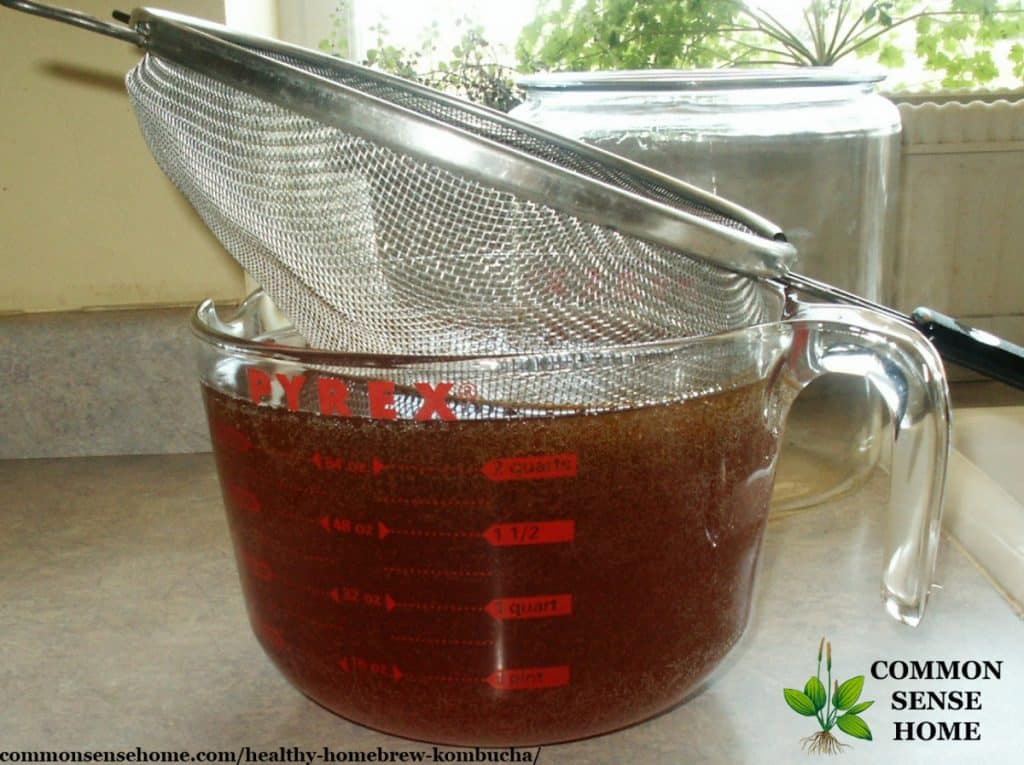
Into the bottles.
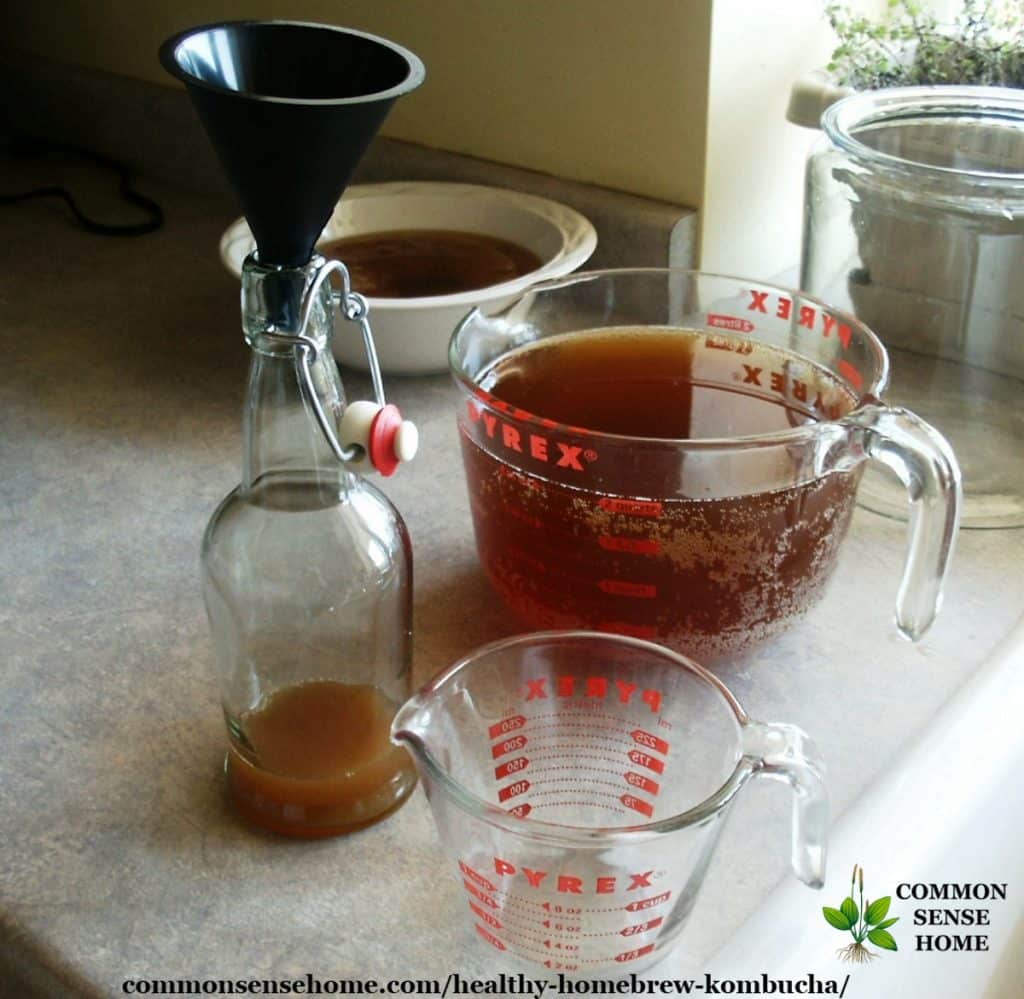
Flavoring the Kombucha
I flavor the kombucha after the initial brewing, when I remove the scoby and put the kombucha into bottles. You can use flavored teas for brewing, but not those that contain essential oils (like Earl Grey). They may damage your scoby. With this batch I tried 1/4 cup apple cider per bottle in two bottles, one with some blueberries, and one with some raspberries. I didn’t measure the berries, I simply loaded them in until they covered the bottom of the bottle.
Leave bottles on the counter for a couple days to produce more bubbles, refrigerate for a sweeter brew.
In addition to the above flavors, I’ve also tried straight blueberry juice, grape juice, honey and ginger (about a tablespoon of each per bottle), and Ghirardelli Double Chocolate Hot Cocoa mix. So far I think my favorite is the blueberries, but all are tasty. It’s fun to munch on the bubbling fruit at the bottom of the bottle.
The chocolate was a hoot. I got a little nervous because the powder formed an obstruction at the top of the bottle and didn’t appear to blend in well. When I finally popped it open (after almost a two week ferment), the carbonation had built up so much (because of the high sugar content) that it blew the foamy chocolate snake right out of the top of the bottle. So much for the bottle getting blocked. Most of the sugar was gone by this point, so the flavor was more like straight, strangely effervescent unsweetened cocoa, but it was still pleasant, and highly entertaining. I think the ginger could use more ginger, but I’m not sure how much. Suggestions are welcome, along with suggestions for other flavors.
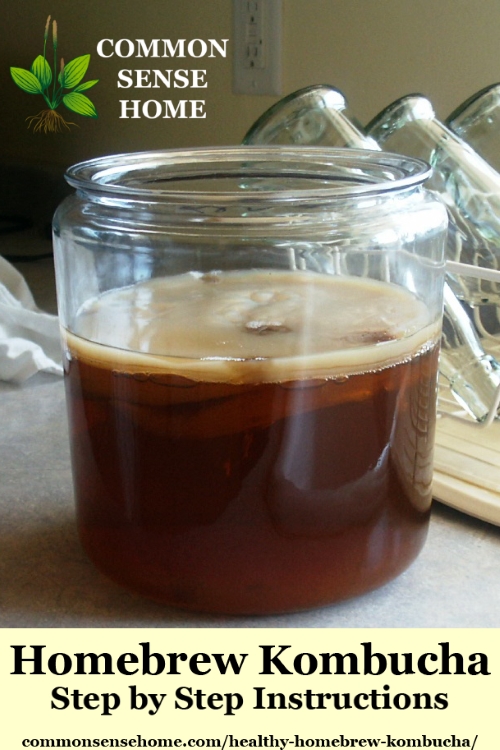
Why Drink Kombucha?
So why the heck am I bothering with all of this? Sure it tastes good, but it’s also good for you. From Kombucha Cultures:
The intestinal microflora is carefully balanced. The human gut is home to around 400 different species of good and bad bugs. However, the good bugs have to share their environment with bad bugs such as Salmonella, E.Coli and Clostridium. The way to balance between good and bad bacteria is to maintain good digestive health, creating stable “microflora”. It is generally recommended that probiotics are taken on a daily basis to create this balance.
Prescription medicines, stress, sickness and especially antibiotics can all disrupt the bacterial balance because as well as killing off the bad bacteria they allso kill off the good bacteria. So you need to restore balance. Probiotics need to be taken regularly to maintain levels of good bacteria. Lactobacillus or lactic acid bacteria is a faciltative bacteria, named as such because most of its members convert lactose and other simple sugars to lactic acid. They are present in the gastrointestinal tract and the vagina. The production of lactic acid makes their environment acidic which inhibits the growth of some harmful bacteria. Large populations lactic acid-producing bacteria regulate the levels of friendly bacteria and reduce the levels of toxic pathogens which cause ill health. Resulting in Kombucha being one of the best skin treatments for acne and an arthritis health drink.
Even though the beverage is acidic, it does not cause any acidic condition in the stomach; it facilitates and noticeably promotes the digestion. The “yeasts” found in the Kombucha are of a beneficial kind. Organic Kombucha Tea is considered by some as a delicious ‘Cancer Foods’ or as a natural alternative ‘herbal nutrition supplement’.
By altering the pH of the large intestine to a slightly more acidic level, putrefactive bacteria (those bad for your health and causing foul wind production) tend to be inhibited or destroyed. There is no kombucha danger, It will cause no harm to have even ingested Kombucha mushroom. The pH is altered by active good bacteria producing high levels of lactic acid. The presence of this and other acids inhibit the growth of undesirable bacteria, molds, mold spores and yeast, particularly the Candida form.
More Posts in the Kombucha Series
- Water Kefir Versus Kombucha – What’s the difference between water kefir and kombucha?
- Kombucha Q and A and More Flavoring Ideas– More flavoring ideas and all the Q and A from the comments in a more readable format
- Holiday Kombucha Flavors – Ideas for holiday flavor blends such as pumpkin spice and cranberry collins
- How to Make Coffee Kombucha – Using coffee instead of tea to brew kombucha
Originally published in 2009, updated in 2017.

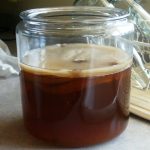

i have thoroughly enjoyed reading how to treat ear mites in cats. You made it so simple – coconut oil! I shave searched and searched and it always leads to chemicals. I’ve tried ACV (Apple Cider Vinegar) but it’s runny, wheras coconut oil is thicker and much easier to work with. Currently I have 4 indoor cats, 3 of which were born feral. I provide food, shelter, and TNR for lots of cats, and I bring any kittens inside for socializing them so they are adoptable. There isn’t much interaction between the two groups, but I do periodically bring bedding inside to wash. Anyway I really enjoyed your style of writing and all my “ear mite stress” melted awat! Thank you! And, now I know what kombucha and it’s health benefits. I’ll be learning more about it and start “brewing” some batches. Again, THANK YOU!
You’re welcome, and I’m glad you’re enjoying the site.
In our area, the local barn cats socialize with our cats when they’re outside. (Our cats patrol the garden and orchards, and have outside cat boxes, but rest inside more often than outside.) Basically, there are plenty of opportunities for mite exposure, but I don’t like using the nasty chemicals, either. I think Reg may be more sensitive to chemicals than some cats, too, as he had a bad reaction to the sedative used when he was neutered. Many of our cats enjoy snacking on a dab of coconut oil, too, so it’s something they like to lick while grooming. (I found this out because one of our cat boys jumped up on the bathroom counter to investigate when I was using coconut oil on my skin, and tried to eat my oil.
Brewing kombucha has become part of our routine, because it’s so easy, and so much less expensive than store bought. The chickens love any extra scobys, too, and if we fall behind in drinking, we can always add it to the garden.
My favorites to add to the second fermentation are raisins, dried cranberries, dried cherries. They are cheaper than organic fruit juices and easy. A couple of tablespoons in each bottle. I like the taste of water kefir but it is more labor intensive than the kombucha, which I also like. I work a full time job, am raising a teenage grandson, do all the stuff you do to keep a home. Almost daily attendance to water kefir gets put off. Sometimes for weeks at a time. I also used the beets in my garden to make kvass. I got worried about drinking all that salt. It tasted very salty. And I began to feel it was not good for me. What are your thoughts? I tried making it half salt and half whey but it has a off taste. I bought some our Saturday market and it didn’t taste salty at all.
I only made kvass once and wasn’t terribly excited about the flavor. I used whey as a starter. I don’t think the salt would be an issue if you drink it in small quantities (shots instead of a glass full). Another option would be to reduce the salt and add a vegetable starter culture like Caldwell’s Vegetable Starter Culture Six pouches 12g .
.
Where can anyone get a “scoby?” Thanks!
You may be able to find someone local to trade with (once brewing has started, a new scoby grows with each batch). Otherwise, a company I trust is Kombucha Kamp. They have scoby kits for sale on Amazon.com at Kombucha Kamp Genuine KOMBUCHA CULTURE (1 Lrg SCOBY + 1 Cup Strong STARTER LIQUID – Makes 1 Gallon)
Can kombucha be made using the mother from Apple cider vinegar instead of buying a Kombucha Scoby ?
I made a batch a few weeks ago using a mother from my homemade vinegar ,while it tastes fine ,I don’t know if it has the health benefits of Kombucha .
You’re fermenting something, but I’m pretty sure it’s not kombucha. I would also guess that it has some health benefits, I’m just not sure exactly how they might differ from kombucha.
There is a water crock shop online (I think that is the name if it) for the water bottles to dispense from. They have a very convenient plastic spout. You can get the silicone lids to fit on top from amazon for $12. Make a gallon of tea now and then after I take out a half gallon (the crock holds 2.5 gallon and I have been doing a continuous brew for 3 years). The bottles in the cabinet make their own SCOBYs with no help, no air, no sugar. You can grind up SCOBYs and make a paste to put on cuts. Some people dehydrate their SCOBYs and feed them as dog treats.
One chick in design school used her bathtub to make a giant SCOBY as the new one takes on whatever shape is at the top of the container. Then she dried it and used it to design an outfit! Pretty sure you cannot wear that in the rain. But it is some neat substance in that mushroom.
My fave flavor was 2nd fermented with cinnamon sticks. Cardamom is good too.Strawberry seemed to make is super fizzy! I save glass bottles from Jones soda and such to refill.
If you do not keep it sealed the gnats will have a field day. You will get a SCOBY with vinegar worms. Compost that and clean vessel w hot water. Start over.
I let SCOBY’s stack up at the top of the water crock and they look like a stack of plate sized pancakes ( or giant amoebas). You can cut a tiny bit of SCOBY and add some soured brew to cook up a new batch. Typically one would bottle it up before it got to the overly sour vinegar stage.
Some of my friends do continuous brewing, too.
Started my mother from a bottle of commercial unflavoured kombucha. Brewed a couple of batches of kombucha with black tea and sugar in a gallon mason jar. Then over the next few patches removed one black tea bag and 20% of the sugar added one green tea bag and a tablespoon of honey. In three or four days sample it, when you like the taste pour off a litre and make some more tea. Don’t add the honey until the tea is lower than 115 F . Adjust amount of honey to taste
Inviting you the Carnival of Home Preserving on my blog today and every Friday. Hope to see you there. Laura Williams’ Musings http://laurawilliamsmusings.blogspot.com
When I started making Kombucha several years ago I was told to never use metal utensils including the strainer because it would react with the metal. I see you used a metal strainer … any adverse effect on the kombucha? I too, was told to always keep my spare SCOBY mushroom/mother in the fridge. I keep them in mason jars. A good source for gallon jars is the deli of your grocery store, or a restaurant etc. You may not use a gallon of pickles or olives up quickly, but they will! Just ask them to save you one … or two!
Lora – the kombucha never sits in contact with the strainer for long, so it hasn’t been a problem. Most storage recommendations I’ve come across since I started brewing recommend storing an extra scoby at room temperature, not refrigerated. Since I wrote this post, I’ve been blessed by friends and neighbors with plenty of gallon jars. 🙂
Hi,
Could you please share where you got those bottles from? I am going crazy looking for well sealing clear glass bottles – found some in stores that don’t seal well that I returned, and resorted to using Grolsch beer bottles for now.
Thanks in advance!
I purchased them at a local home brewing shop called House of Homebrew (www.houseofhomebrew.com). They are typically used for beer. The brand name is EZ Cap. You may be able to find a dealer closer to you through their website – http://www.ezcap.net/
I hate to be a stickler, but don’t you mean symbiotic rather than sybiotic?
Michael – thanks for the heads up! That post has been up for over two years and no one was kind enough to correct my typo. I’m notorious for fat-fingered typing.
Hi. I just found your blog a couple of days ago and I love it! I’m looking forward to trying the lotion bars and other homemade toiletries.
I recently started a new blog after several months of not blogging and today I posted about our adventures in kombucha-making. I have to say, your audience is much more receptive to it than mine is. I still have a small readership at this point, but to a person they are not interested in even trying it, let alone making it.
I can’t wait to try some of the flavorings you’ve mentioned!
BTW, my husband loves pickles, so we bought several gallon pickle jars. He enjoys the pickles, then we use the jars for fermenting. 🙂 They are more narrow than the depth of our liquid, but so far, they’ve been working just fine.
Thanks for your kind words. 🙂
Kombucha tends to be an acquired taste – don’t lose heart. These posts have been on the internet for a long time, so the comments have come in over that period, not all at once. Maybe you’ll get some converts over time.
I use gallon pickle jars, too, when I increase production. I was brewing for a friend for a while in addition to my own use. They work fine and the price is right. 🙂
Great information here! Wow, your method of making the tea is much more detailed than ours. 🙂 It’s fun to read how other people do it. I heard about the Wild Fermentation book a few weeks ago and I was wondering if there was something in there about kombucha, I figured there must be!
Thanks for sharing the health benefits too. I Googled for that information when I wrote my post about kombucha but couldn’t find a good source.
So far, our favorite flavors are pomegranate and also pink lemonade (fun to experiment!). I like the idea of using whole fruits, I’ll have to try that. I wonder if pineapple or watermelon would be any good. Hummm… can’t wait to do more experimenting!
The person we got our scoby from told us to refrigerate it too. She said it slows down the fermentation process.
Here’s the post I wrote on my blog if you’re interested to see how we do it… Kombucha Tea
Amy
I haven't tried kimchi yet, but I do make raw sauerkraut. Maybe this fall…
You should try Kimchi too if you like the Kombucha, it's fermented cabbage,similar benefits to the tea.
I LOVE Kimchi, recently tried Kombucha from the health food aisle (no thanks) but I am salt sensitive. Any ideas for me? (I have to keep my daily intake under 2000 mg).
Have you tried kefir? There’s water kefir and milk kefir, and I believe they are both low in sodium.
I have been dying to make kombucha for a while now, and once I did I was gonna post about it! Thank you so much for linking up with Healthy 2day Wednesdays! I look forward to other posts you may add! Hope to see you there this week!
Jasmine – if you can't find a SCOBY online, you can grow your won from a bottle of tea. Here's a YouTube video on how to do it: http://www.youtube.com/watch?v=1A5Uur2OgDo Cultures for Health (link on sidebar) also sells SCOBYs. I believe they ship theirs dehydrated.
The more you drink it, the more you get used to the taste. When you brew it yourself, you can adjust the flavorings and brewing time to change the flavor. Good luck!
Just tried Kombucha for the first time today. I did not like the flavor too much but about 15-25minutes after drinking I was highly impressed with how my body began to feel afterward. I was more alert, had a nice boost of energy and I felt good, balanced. Would love to drink this stuff daily but not interested in paying $4 a bottle! Hopefully I can find a Mother around here.
Hi Vicki.
Well, I'm new at this, but have worked with bread yeast for a long time, so I would think some of the properties are similar. I probably had my scoby rolling around in the back of the fridge for a month or more, and when I started it up it was fat and frisky and took off without any trouble. The friend I got it from told me to keep my spare in the fridge, so I have.
I always freeze or refrigerate my bread and brewer's yeast to extend its shelf life. It may go dormant, but comes back to life when it's warmed up. Since the scoby is bacteria and yeast, I would think the same principles would apply. Of course, I have just started brewing this year, so I may be wrong.
I believe that most scobys that are shipped online are shipped with ice packs/cold packs. Maybe this is to avoid extreme high temps more than anything else? From my experience it seems both bacteria and yeast are more tolerant to cold than to extreme heat.
Laurie, I've tried a couple of diff ways to get ginger flavor. First time I added 1T raw ginger, diced. Lots of carbonation, flavor was light. Next time I made a ginger tincture: lots of heat, but not as much flavor. So am thinking of combining those methods…
BTW, I've seen where folks use either ginger syrup or candied ginger, w/ good results. Good luck!
Vicki in Orlando
Candy Jane, the SCOBY does not need to be refrigerated; keeps just fine @ room temp. One way some folks transport is to cut the SCOBY into a long ribbon, then put in a small bottle of kombucha. (Same size as toiletries.) You don't really need a sizeable SCOBY to start the batch!
Good luck!
Hey, Laurie. Surprised you said you refrigerated your SCOBY. A lot of "authorities" say to not do that, and that it will no longer work after refrigeration… How long did you leave it in the fridge before you took the plunge?
Vicki in Orlando
I know there are quite a few natural foodies out that way – I wonder if there is a way you could make contact and just get a scoby from someone? I know they generally do ship them with an icepack, although in our weather for short distances WE certainly wouldn't need them. This cold is ridiculous.
Great post on fun project – and thanks for the "healthy info", makes much more sense when you know WHY some of these funky things become popular. I'm loving my flavors, especially raspberry made from frozen from our garden. Thanks for my "baby", and I keep a spare in the frig…
Now working on how to transport a SCOBY to Oregon in a few weeks, via suitcase. May have to overnight it with an icepack (?). The kombucha will be good for me and Mom both, over the winter months on the coast.
LOL – what recipe did you use, how long did you brew it and did you try a secondary brew? The longer it ages the more "funky" the flavor – thus the original "old sock" smell.
I confess, I've got some Lipton that I'm using up to start with, but I've bought black tea to switch to after that's gone. I'll drink it after the initial brewing, but I much prefer the taste after brew number two. The flavor mellows significantly as it is aged during the second brewing. A shorter first brewing will give you a sweeter brew, too. I've been averaging 1 1/2 to two weeks on the first ferment, one day to up to two weeks on the second.
I bought that same jar this summer when I made kombucha. I have to say though, all that work and no one liked it, not even me!
My dh says that SCOBY looks like a placenta. 🙂
You can do it, Michelle – just find a little time and the right brewing vessel. It's really much easier than a lot of the stuff I've tinkered with over the years. If you grew your own scoby that's probably the toughest part.
I like my flavors, too. 😉 Sure, I drink water, but flavor and fizz are more fun.
Awesome post! I grew my own scoby this summer, but I have yet to brew a batch with it. (I need to!) I too like the flavored ones in the HFS ~ I love how you experimented with different flavors! *Ü*